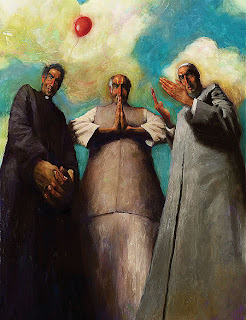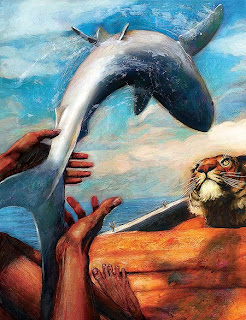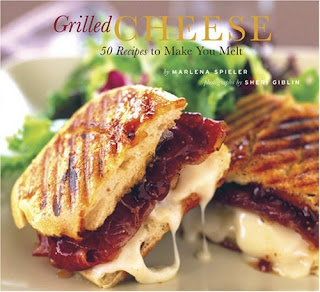
… when you discover a taste for the unthinkable?
Could you be drawn into a murder?
For friendship?
For a way out of your dreary experience?
These are the haunting words on the back cover of the novel Out by female Japanese novelist Natsuo Kirino (Book #46 for 2009, Book 7 for diversity challenge – book discussion selection).
I had been mulling over my choices for this month’s FFP discussion, which will center around Japanese books. I have a bunch of Murakamis in my TBR, but I read Norwegian Wood last year and I don’t think I am ready for another one just yet. I also have Snow Flower, Secret Fan by Lisa Yee, but I also just recently read Memoirs of A Geisha and I wasn’t in the mood for another geisha novel so soon. I was considering reading a couple of manga books, when I took out the front stacks of my TBR shelf and found this book.
I’d been terribly busy the past week, so I was apprehensive that I wouldn’t be able to finish this book, at 520 pages, but I read a few odd chapters Wednesday night, polished off nearly half of it last night, and finally finished it off about an hour ago.
Researching on Natsuo Kirino for the weekend’s discussion, I found out that Out is actually an award winning novel: it received the Grand Prix for Crime Fiction, Japan’s top mystery award, and was a finalist (in English translation) for the 2004 Edgar Award. It is also Kirino’s first novel published in English, and the US film rights have been bought by New Line Cinema, to be directed by Nakata Hideo (of The Ring fame).
It was also interesting to find out that Natsuo Kirino is one of the most famous writers in the rise of Japanese women’s detective (misuterii) fiction that started in the 1990s, who have uniquely used the genre of detective fiction to depict and comment on present-day Japanese society and the Feminist situation.
Translated by Stephen Snyder, Out is a gritty crime novel about 4 women in contemporary, urban Japan: Yayoi, Masako, Yoshie, and Kuniko, who work on the night shift in the assembly line of a bento box factory. The foursome leads a troubled existence, each in their own way: Yayoi has a philandering and gambling husband; Masako is estranged from her husband and son right in her own home; Yoshie is a struggling widow with an ailing mother in law and a wayward daughter; and Kuniko is a shopaholic buried in debt.
One night Yayoi turns up at work dazed, and they find out her husband has beaten her, and she reveals that he has gambled away all their life savings. The next day, Masako gets a phone call from Yayoi asking for help — she has killed her Kenji in a fit of rage. Masako volunteers to dispose of the body, enlisting the help of Yoshie and Kuniko. The three dismember Kenji’s body and fill several trash bags, divided among themselves for disposal across the city.
The story gets more complicated after the body parts are discovered in a city park, and the police start investigating. But the women have more than the police to fear — a money-grubbing loan shark who figures out what they’re done, and a menacing nightclub owner who loses everything when he becomes the primary suspect in their crime and is now out to exact his revenge.
Out is definitely not for the weak of heart — it pushes the envelope on conventional views on sex, violence, feminism, and justice. I’m one of the less squeamish readers I know, but even I found this novel difficult to take in. It took me a while to remember why I actually mooched this book, and after racking my brains I remember why — I came across it in a recommendation list after I read Perfume by Patrick Suskind (which I have yet to review, but I’m looking forward to rereading it for an FFP discussion this year, so I’ll save it for then).
Out is similar to Perfume mostly because of the methodical procedures related to the murder (Grenouille’s approach to murder in Perfume and the carving of Kenji’s body parts in Out). Reading this book, I felt like I was watching episode after episode of Crime Night, and while uneasy, I was also reading in morbid fascination, much like I had read Perfume.
But the similarities end there. While I sympathized with Grenouille’s character in Perfume, I clearly knew he was psychotic and I can honestly say I would never go on a rampage like him. In Out, I could identify with the four women, as real as they come, who each dreamt of an escape from their lives, a way out. And it really got me thinking: would I do the same if I were in a similar bind?
I remember a text message I’d exchanged with some gal pals some years back; I don’t remember the exact words, but it went something like this: if I had killed a man, my friends would show up on the doorstep with a shovel, no questions asked.
Would I do it if a friend asked for my help?
What would it take to push me across the line?
The questions are haunting, but they do make you think.
As this is the first Japanese detective fiction I’ve read, I’m amazed that the Japanese culture has a long history of mystery writers, and is probably the only culture outside the Western world that has successfully assimilated this genre.
I’m also blown away that female Japanese writers were able to take this Western genre and make it their own (Japanese women’s detective fiction is a very popular genre, apparently), giving us an insight into the female situation. So many issues were successfully tackled in this book that were seamlessly incorporated into the story — domestic abuse, prostitution, poverty, climbing up the corporate ladder, beauty, weight, self-image — not easy, I imagine, but Natsuo Kirino does it quite well.
Now that I’ve discovered Japanese detective fiction, this opens a whole new world for me in mystery books — it’s a whole new genre to explore!
That’s it for now, must pack
for the weekend!
***
My copy: Vintage trade paperback, mooched from the US
My rating: 4/5 stars








 I’ve been in the middle of a book for some days now (Pagan in Exile), and admittedly, I’ve been losing interest in it. So tonight I decided to “cleanse the palate” with a cookbook, my first cookbook review for the year :)
I’ve been in the middle of a book for some days now (Pagan in Exile), and admittedly, I’ve been losing interest in it. So tonight I decided to “cleanse the palate” with a cookbook, my first cookbook review for the year :)



